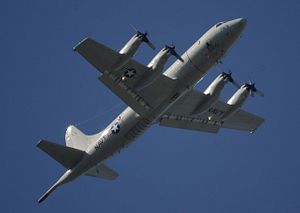A U.S. Navy P-3C Orion surveillance aircraft and a Chinese military surveillance aircraft came within 1,000 feet of each other over the skies of the South China Sea, according to an unnamed U.S. official who spoke to Reuters.
According to the report, the incident took place near Scarborough Shoal, in the eastern reaches of the South China Sea, 124 nautical miles off the Philippine coast.
Scarborough Shoal is claimed by both China and the Philippines and the Chinese Coast Guard has maintained a presence there since seizing it from Manila in a stand-off in 2012.
A spokesperson for U.S. Pacific Command, Maj. Rob Shuford, confirmed to CNN that the U.S. Navy is describing the incident as “unsafe,” though CNN notes that this doesn’t mean the Navy is ascribing “malign intent” to China just yet.
“The U.S. Navy P-3C was on a routine mission operating in accordance with international law,” Shuford noted.
“The Department of Defense and U.S. Pacific Command are always concerned about unsafe interactions with Chinese military forces,” he continued. “We will address the issue in appropriate diplomatic and military channels.”
The U.S. P-3 aircraft reportedly had to alter course to avoid an aerial collision with the Chinese aircraft, which was reportedly a not a fighter designed for interception, but a KJ-200 aerial early warning and control (AEW&C) aircraft.
PACOM, accordingly, has not described Thursday’s incident as an interception attempt.
China’s People’s Liberation Army Air Force has usually used its Shenyang J-11 and Chengdu J-10 fighters for interception in the East and South China Seas.
The most recent “unsafe” encounter took place last June, between a U.S. Navy Boeing RC-135 reconnaissance aircraft and a Chinese J-10 fighter over the East China Sea.
Additionally, last May, a U.S. Ep-3 Aries signals reconnaissance aircraft was intercepted by two Chinese fighters over the South China Sea in an incident that the U.S. Department of Defense described as “unsafe.”
With details still slim, it’s unclear if this incident is the sort of “test” of resolve that China may have been looking to subject the Trump administration to early on, mirroring the 2001 Hainan incident and the 2009 USS Impeccable incidents.
A December seizure of a U.S. underwater research glider by a Chinese People’s Liberation Army-Navy vessel was seen by some South China Sea analysts as a test of then-President-elect Trump.
If the initial impression of Thursday’s incident holds up, it may not quite be as serious as the two intentional intercepts observed in 2016, but it could nevertheless corner the Trump administration into issuing a stern rebuke toward China — something we haven’t observed publicly just yet since Trump’s January 20 inauguration.
As I’d discussed yesterday, there’s considerable potential this year for U.S.-China tensions to spike in the South China Sea and elsewhere.

































